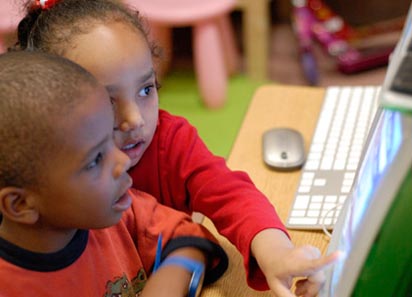What's Behind Being Behind?
December 16, 2009 - With nearly two out of every three children living at or below the poverty level, Philadelphia public schools have one of the highest rates of child poverty in the country. The city's children face significantly higher rates of maltreatment, homelessness, and biological birth risks, and have mothers with comparatively low levels of education.
Is it any wonder these kids often struggle in school?
 For decades, educators and child development specialists have known that biological and environmental risk factors correlate to lagging performance in school. But, in close collaboration with Penn GSE Professor John Fantuzzo, GSE Research Associate Heather Rouse Gr'07 has been able to establish exactly how all these risk factors influence the school lives of Philadelphia children.
For decades, educators and child development specialists have known that biological and environmental risk factors correlate to lagging performance in school. But, in close collaboration with Penn GSE Professor John Fantuzzo, GSE Research Associate Heather Rouse Gr'07 has been able to establish exactly how all these risk factors influence the school lives of Philadelphia children.
To understand and analyze the complex interplay of poverty, maltreatment, homelessness, low maternal education, biological birth risks and their influence on schooling, she used the Kids Integrated Data System (KIDS). Developed by a team of Penn researchers, KIDS organizes the data of various municipal agencies promoting child health and welfare, and makes it into a powerful analytic tool.
Using KIDS, Rouse explains, "because of the wealth of information in these administrative data systems, our models are able to capture comprehensively the experiences of children — to really see what happens from [ages] 0 to 8. It's not just, did they go to preschool or not? It's a whole picture over time."
A recent study conducted by Rouse and Fantuzzo, provides a detailed blueprint for educators and policymakers searching for effective points of leverage to improve the lives of children who grow up in poverty.
First and foremost, this study found all five risk factors have a powerful impact on childrens' learning — they affect policy-relevant outcomes like reading and math proficiency and second-grade retention.
What's more, the type and amount of risk matter as well. For example, homelessness is one of the strongest indicators of school absenteeism, school suspensions, and low social skills. Maternal education — although often associated with family income — is a better predictor of academic outcomes than poverty alone. In addition, the study showed that, whatever the risk, each additional risk experienced increased the likelihood of poor outcomes.
For Rouse, the message for policymakers is clear. Put simply, what happens outside the classroom has a huge effect on school outcomes — kids don’t leave their lives behind when they walk though the schoolhouse door. We now know how much it matters and the evidence is strong that policymakers can’t afford to ignore the state of childrens' lives when they grapple with education reform.
Take low maternal education for example. Across the board, controlling for the effects of all other risks, having a mother without a high school education is one of the strongest predictors of children’s educational outcomes. "So why haven't we been more focused on two-generation programs?" Rouse asks.
Or look at homelessness. The study data showed that 95 percent of children's first homeless experience happened during in the first five years of life. “"Why can't we partner the homeless shelter system with early child care providers?" Rouse wonders. "What if we had intake coordinators at homeless shelters and anytime a mom came in with a child who is not yet school-aged, we enrolled them in a formal early childhood program? Talk about early intervention!"
Policymakers need evidence to guide their decisions. And with KIDS, they can get just the kind of evidence needed to create effective programs for children. Sure, most of us could confidently say that we know these risks are bad for children. But using KIDS for longitudinal research like this study, Rouse adds, you can understand "exactly how and why they're bad and when they happen."
Rouse's article, "Multiple Risks and Educational Well Being: A Population-Based Investigation of Threats to Early School Success," appears in Early Childhood Research Quarterly, 24(1).
